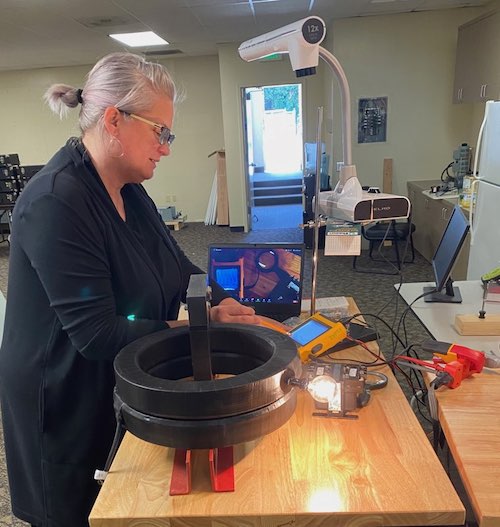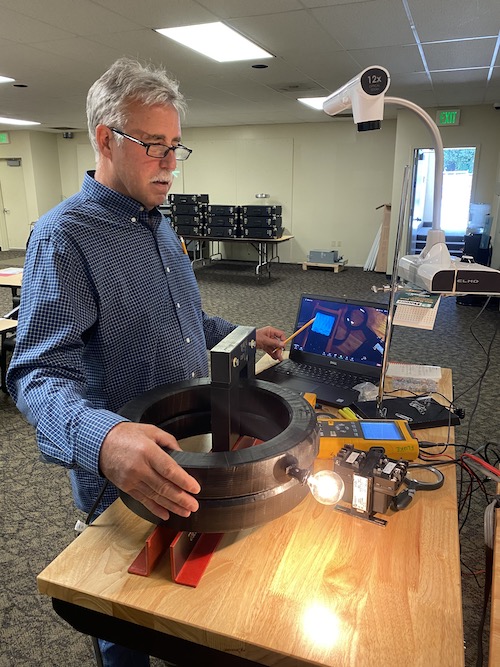Apprenticeship education in inside construction was experiencing plenty of change before the COVID-19 pandemic brought the North American economy to its knees in March.

|
| Christie Peterson, a lab instructor at San Francisco Local 6’s JATC, shows the relationship of AC voltage and ampacity on a meter during virtual apprenticeship classes.
|
Months later, leading instructors and experts expect the changes to continue as the pandemic drags on, perhaps even after it ends. If anything, they say, it will spur change at an even faster rate – making for better-prepared apprentices.
“It’s kind of forced us into accepting and using these things like virtual learning and remote learning that were on the horizon anyway,” Construction & Maintenance Director Michael Richard said. “I think we’ll come out better for it.”
Virtual learning has been making inroads at many JATC training sites for several years. Increasingly, apprentices work on real-world simulations looking at a computer screen, often modeled with situations seen on a jobsite.
That isn’t intended to replace hours worked in the field. Rather, it was another tool for instructors looking to make better use of classroom time and get apprentices better prepared for when they do go out for on-the-job experience.
What had begun to change more recently, however, was how remote learning had become so advanced that many instructors could work with apprentices without them even coming into the training center. They could stay home in front of a computer and learn the skills of the trade while getting feedback from an instructor who could be across the street – or hundreds or thousands of miles away.
“We had started in the last couple of years to move our curriculum over to computer-mediated learning,” said Todd Stafford, executive director of the Electrical Training ALLIANCE, the educational partnership between the IBEW and the National Electrical Contractors Association. “The idea is to use the hours at the JATC as hands-on training as opposed to lecture-based training.”
Stafford said those changes are especially beneficial to the apprentices themselves. The onset of the pandemic likely will cause those JATCs who haven’t made the changes as quickly as others to catch up.
“It does make it a better learning experience for the apprentice,” he said. “He or she can go back and review content, lecture materials, all the different tools we use. And, a student can see it and view it multiple times.”
The transition was well underway at places like Pocatello, Idaho, Local 449, which draws apprentices from all over the enormous state. Now, apprentices don’t always have to drive several hours to attend class, especially after a long day on the job.
“There are challenges but [the pandemic] has also opened the door to what we’re capable of doing,” training director James Smith said. “These are things we’ve always thought about because we are such a spread-out area. It definitely shows we have the capabilities to teach online.”
For San Francisco Local 6, the challenge is different. About 440 apprentices were taking classes in its training center, a former Catholic girls school in the heart of the city, when the pandemic struck.
Space was at a premium and holding classes while following social distance guidelines was impossible. Moving them outside – as some local training centers did – was impossible because there was just a small parking lot. Many apprentices rely on public transportation.
That forced training director Peter Chursin and his staff to change their approach quickly, and Chursin is pleased to report it went better than expected. He said Kristina Vennarucci, an instructor at the training center, took the lead and helped her colleagues become proficient in Zoom, a videoconferencing platform that’s been popular during the pandemic.
They also installed Enos interactive whiteboards with overhead projectors, which allowed instructors to observe and grade apprentices on various tasks, whether it was bending pipe or working with conduit.

|
| Bart Murray teaches apprentices how to work with a transformer nameplate during virtual classes at the San Francisco Local 6 JATC, where Murry works as a lab instructor.
|
“Having to piecemeal everything in, I expected us to really skin our knees and have some glaring hitches,” Chursin said. “We did have a few, but nothing we couldn’t handle.”
Because the pandemic is ongoing, Chursin said he expects to use a similar system when apprentices return later this summer. He also thinks virtual learning will play an increasingly important role after the pandemic ends.
Still, he’s not quite ready to call it the wave of the future, especially for a local in an urban area. Some Local 6 apprentices drive nearly two hours from Sacramento for classes but many live in or near San Francisco.
“I actually would suggest that people slow the roll a little bit,” he said. “Let’s see what happens and how this plays out. We do have blended learning we use all the time, but I don’t see butts in the seat changing. Our people can get here [to the JATC once the pandemic ends].”
Even the best infectious disease experts have a hard time predicting how long the pandemic will last. That makes predicting the impact it will have on construction and apprenticeship education difficult, said Al Davis, an international representative in construction and former business manager of Las Vegas Local 357.
But Davis hopes it does not have the same impact as the economic crash in 2008, which set the construction industry reeling. Many JATCs cut back heavily on apprenticeship education because of that. Some even eliminated classes entirely for a year or two.
Because of that, the IBEW and other construction unions struggled to meet the demand for workers when the economy rebounded, especially as baby boomers began to retire.
“That is a concern,” Davis said. “I’m of the belief you always have to take an apprenticeship class, but it’s a balancing act. You are making a commitment to that young man or woman that they’ll be paid over the next five years and they’ll have the skills to go to work.”
Like others, Davis thinks the emphasis on virtual learning will increase due to the pandemic and the aftermath. That’s good in one sense because it will increase time apprentices can take part in hands-on work, he said.
But he hopes it doesn’t take away from the camaraderie apprentices often have with their classmates.
“It was always a big deal for everyone to be in the same room,” Davis said. “When we finished every year, we would take them all out back for a big barbeque. You hope you don’t lose things like that.”
Added Richard: “Anything we can do that streamlines the process without compromising the delivery of the curriculum, and affords the JATCs more hands-on instruction, is a good thing. The curriculum is essential, but hands-on application and essential skills is really what makes a good apprentice and a good wireman.”
In his role, Stafford has seen apprenticeships often compared to traditional higher education in this country – something that isn’t quite accurate.
The Electrical Training ALLIANCE and the JATCs answer to the Labor Department, not the Department of Higher Education, like colleges and universities do. Their essential mission is to ensure apprentices have the skills to go immediately on a job site and go to work once advancing to journeyman status. Colleges have no such charge, even after offering a degree, he noted.
As long as that is the focus, he’s confident apprenticeship education will make the needed adjustments.
“The training will always be here,’’ said Stafford, who is a journeyman wireman and also has a bachelor’s degree in electrical engineering from Louisiana State University. “We’ll find a model that will succeed and make it work for our local training instructors. We’ll strike the right model to make sure our apprentices have the tools to be successful journeyman wiremen and linemen.”